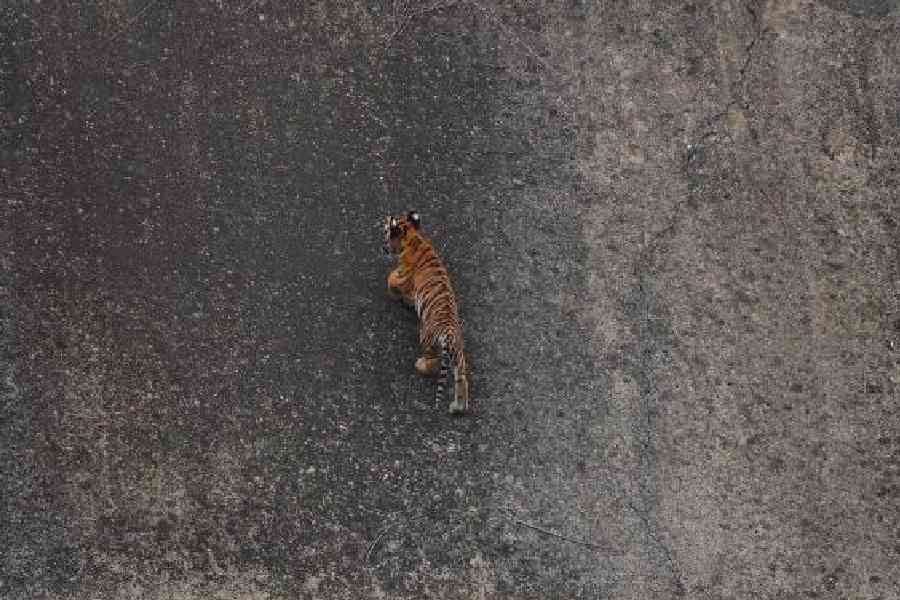Brahmapuri, located in Maharashtra, is the headquarters of the Brahmapuri taluka in Chandrapur district. Should you do an online search for Brahmapuri Territorial Forest, you could be guided to nearby places, like the more famous Tadoba. Brahmapuri Territorial Forest remains an enchanted space many search engines have yet to discover. I would prefer Brahmapuri to remain as it is now — green, verdant, mysterious and awe-inspiring.
Fed up with my routine urban existence, I turned to Sunil Limaye’s invitation to visit Brahmapuri. As an IFS officer and the former principal chief conservator of forests, Maharashtra, he is fondly known as the Father of Tadoba and is a dear friend who appreciates my love for the great wild outdoors. I knew Brahmapuri would be captivating.
The forest area is approximately 1,200sqkm, divided into north and south Brahmapuri with tigers inhabiting both. An official count shows the presence of 62 adult tigers, 19 sub-adults and 23 cubs. The ratio of tigers and tigresses present per square km is far less than the acknowledged permissible limit, creating a complex tangled web of parenthood and progeny leading to unique, unheard-of adjustments and survival modes among the animals.
The forest area is so dense that trails permit only bikes and cyclists for regular forest patrols. There are hardly any safari tracks as seen in other territorial forests. However, the entire area is also interspersed with villages as it is within the tehsil area with inhabitants living in the jungle for generations.
Faced with the challenges of protecting the diversity of Brahmapuri forest area and its denizens, both state and central governments are working to relocate villagers to other places with parallel livelihood facilities. It is an uphill task, as villagers are rarely satisfied with compensation packages despite man-animal conflicts over the years that have claimed the lives of local people. Thanks to the relentless efforts of forest department officials, including intensive awareness drives, this year there have been fewer reports.
The Ekara forest rest house built in 1946 inside Bramhapuri needs a special mention because of the food… the Gaurani country chicken.
Forest talk
It was time for an excursion into Brahmapuri Territorial Forest. I set out in a regular forest vehicle with five other forest department officials to explore. Sunil Limaye accompanied me. We stopped for a quick round of tea and “forest talk” followed in the vibrant green surroundings. Mangesh Tante, a young official of Maharastra’s forest department gave me the lowdown on the tiger population of the area, and the idiosyncrasies of the predators. I asked him how they tackle man-animal conflicts in the area. The entire team pitched in with responses, sharing anecdotes about how tigers are learning to adapt in amazing ways to diverse environments. Tante informed that due to the low density of the prey base, tigers have been known to go, at times, without hunting and eating for more than a week.
We proceeded on our safari. Summers in the Indian subcontinent can be harsh and unforgiving. But inside the forest, despite the humidity, it is a different world. Brahmapuri, even at the height of summer, displays the unmistakable features of a grand tropical deciduous forest. Its distinct ecosystem is an interdependent play of water, sunlight and air circulation.

A two-month-old tiger cub learning to navigate the canal
As part of the six-member team, I travelled deep into the forest in search of the tiger. It was dark, humid, and full of forest smells created by hundreds of plants native to Brahmapuri and the region. I was aware of the dense network of trees that made the forest dark and secretive and noticed trails leading nowhere, created not by humans but by animals.
The roar
While moving across the forest, we came upon a tigress with a litter of four. Her adorable babies were playing about her as the grand dame sprawled by a canal. The jeep stopped. I was out in a trice with my photography gear. The rest waited near the vehicle while I cautiously trod closer to the canal. I could see the tigress with her litter on the opposite bank of the ditch.
Soon, I was blissfully clicking away the tiger cubs, capturing them with my camera lens. Tiger cubs are said to be some of the most adorable and playful babies in the world, full of happy curiosity and energy. Watching the quartet was a heart-melting treat. I noticed a distinct change in the tiger’s behaviour; I found them to be shy. The serenity of the atmosphere was pierced by an ear-splitting roar. Mamma Tigress was not pleased with my presence… a paparazzo!
Anyone remotely interested in tigers knows that an adult tiger’s roar can cause temporary paralysis in animals, including humans. Luckily, I could hear frantic voices calling out behind me. My friends from the forest department were shouting at the top of their lungs: “Back off. Come back, come back.”
Having been a part of several forest expeditions and experienced close wildlife brushes, I quickly retreated and ran back to the jeep, only to learn that the tigress may have landed on top of me with just two jumps — into the ditch and out of it. I was spared her fury. This experience will be etched in my mind for many decades to come.
Don’t change
I lost my heart to Brahmapuri. It was thrilling that I was in tiger territory with nearly 100 predators of adults, sub-adults, and cubs prowling the area. Self-centred it may seem, I hope Brahmapuri remains as spellbinding as it is today, a hidden jewel somewhere in Western India.
Shiladitya Chaudhury is a communication consultant and a restaurateur co-owning popular brands Oudh 1590 and Chapter 2. His passion for wildlife photography takes him to the remotest of locations
Photographs shot on Sony A 7 Mark 3 with 200-600 lens and RX 10 Mark 4










